The iPad Air Review
by Anand Lal Shimpi on October 29, 2013 9:00 PM ESTiPhone to iPad: CPU Changes
Although the iPad Air uses the same A7 from the iPhone 5s (and M7 motion coprocessor), there are a few minor differences that do lead to better performance.
At a high level we’re still talking about two 64-bit Apple Cyclone cores with 128KB L1s (64KB I$ + 64KB D$) per core, a shared 1MB L2 cache and a 4MB L3 cache that services the entire SoC. Apple increased CPU frequency from 1.3GHz to 1.4GHz in the iPad Air, a mild increase but in line with what we’ve seen from previous iPad designs. That’s the first impact on performance - a 7.69% increase in CPU frequency.
The second impact on performance is something I only noticed while digging around under the hood of the A7. It seems like the implementation in the iPad Air can, for whatever reason, hold more instructions in flight (over 20% more) than the A7 in the iPhone 5s. It’s unclear to me whether the A7 in the iPad is configured any differently via firmware/microcode or if perhaps we’re looking at a slightly different revision of the core, but the delta was repeatable in my testing.
The third, and likely biggest change impacting the iPad Air’s implementation of the A7 is the additional thermal headroom afforded by the larger chassis. I’m not going to go into details on exactly what this next test does (unfortunately we’re going to occlude some of the low level work that we do in light of all of the benchmark cheating going on), but we’re looking at a curve of performance vs. time for a particularly power heavy mix of code. We’re running the same exact code on both the iPad Air and iPhone 5s here, the only real difference is the size of the chassis:
You can see the 5s throttles back its CPU frequency to about 1GHz after the 2 minute mark. The crazy thing is that until that point the 5s manages to run at full frequency without so much as a hiccup for two full minutes, running an incredibly power hungry task. Given that most iOS apps aren’t this power intensive for such a sustained period of time, iPhone 5s users should almost always see the A7 running at a full 1.3GHz. Pretty crazy.
The iPad Air by comparison shows much more controlled behavior. Early on in the test we see a 7.7% performance advantage, which lines up perfectly with the iPad Air’s 7.7% CPU frequency advantage. By the end of the test the iPhone 5s has throttled to 900MHz, while the iPad Air drops to around 1.2GHz. At this point the iPad Air’s performance advantage grows to almost 40%.
CPU Performance
I've gone through our standard set of cross-platform browser based benchmarks to place the iPad Air's performance in perspective. As I mentioned in our 5s review, I don't know that there are many (any?) applications on iOS 7 that can really take advantage of all the A7 has to offer. There's definitely a ton of headroom left in the design. What's particularly exciting is when the A7 ends up in n-1 or n-2 iOS devices and it becomes the minimum developer target going forward.
I won't go through all of the results here again, but it's safe to say that the iPad Air is the fastest ARM based tablet on the planet at this point.
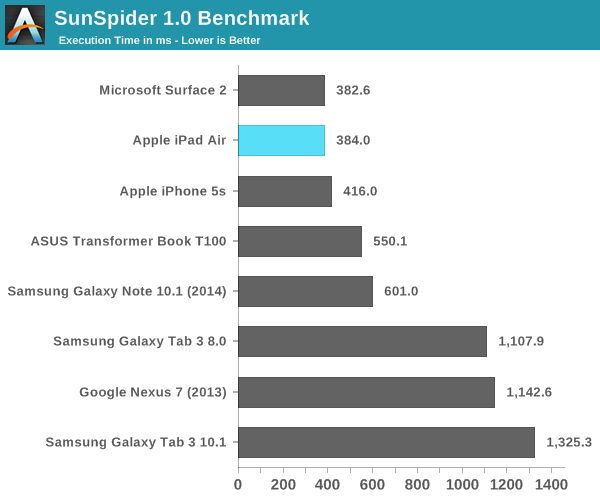
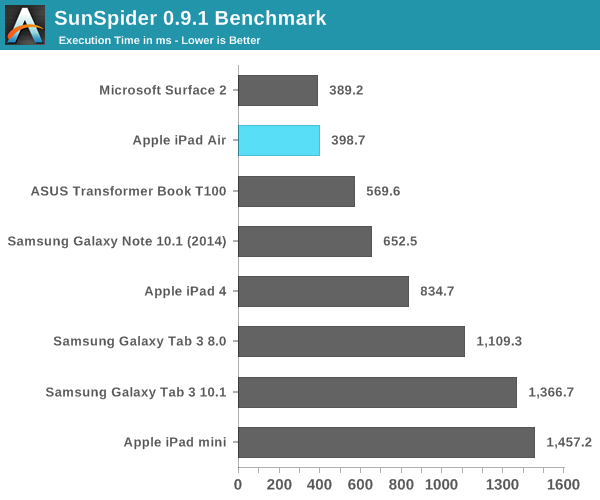
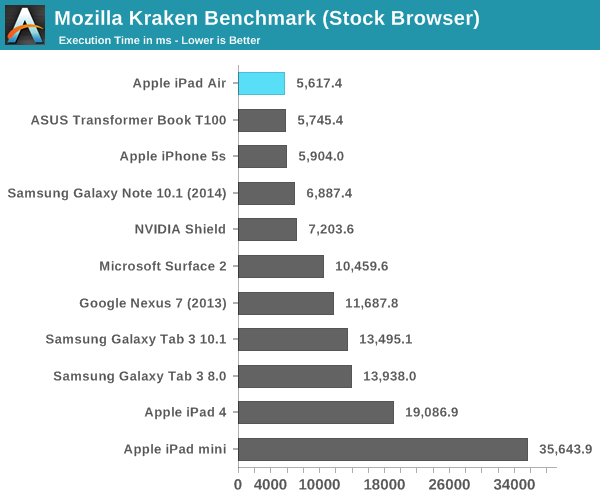
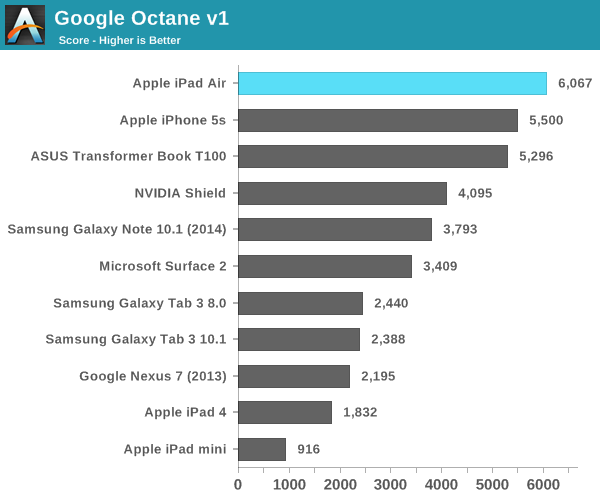
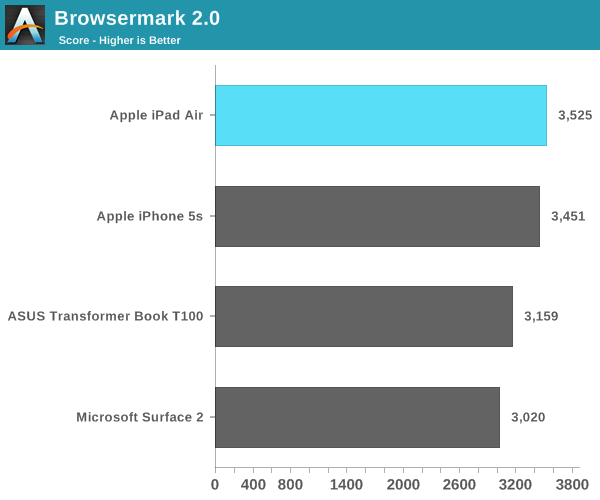

A7 Power Consumption
I’ll get to battery life in a bit, but I’ve been curious about the dynamic range of power consumption offered by Apple’s new A7 SoC. On the one hand we’re dealing with a lower power process (28nm vs. 32nm), but on the other hand Apple’s Cyclone cores can clearly draw more power given how beefy the architecture is this round. Apple frowns upon review sample dissection so I had to turn to a less scientific method of external platform level power measurement. The fidelity of the numbers here aren’t all that great but it’s better than nothing.
For the first test I measured platform power consumption during a Kraken run:
I purposely started measuring before the benchmark so I could get an idea of idle power consumption. The iPad Air consumes roughly 72% of the idle power as the iPad 4, both running at the same brightness. Here we’re not just seeing the A7’s advantages but also things like lower display power.
Focusing on the load portion of the measurement we see that both the new iPad and old iPad consume the same total power in this test. I suspect the A7 is drawing more power than the A6X, but it’s masked by a lower power display. Given how much faster the iPad Air is, Apple’s latest tablet features far lower overall task energy than the outgoing iPad 4. This is probably both the best case scenario for the iPad Air and the most likely case as well.
For kicks I wanted to see just how much power I could get the iPad Air to draw. Here I’m looking at platform power during our mini-power-virus test from above:
How’s that for dynamic range? Almost 12W running all out, but around half that in what we’d normally consider to be a stressful CPU test. I couldn’t get any actual applications/games on the iPad Air to behave like this so the results above are purely academic (for now). A quick run through GFXBench 2.7’s T-Rex HD test confirms that even pushing the GPU won’t hit these numbers. The max I saw running T-Rex offscreen was ~6W, and turning to an actual game (Infinity Blade 3) the iPad Air pulls less than 5W.


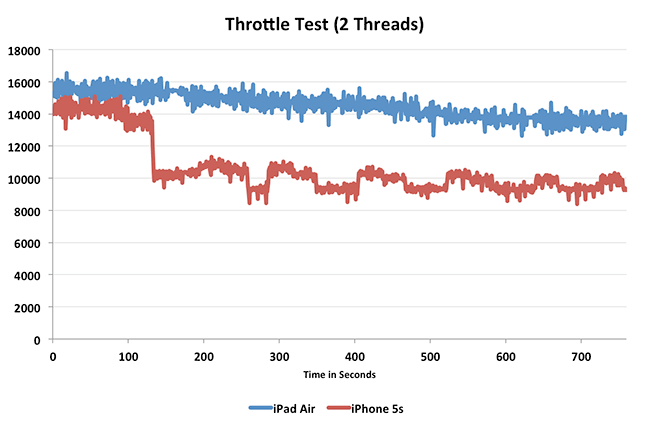
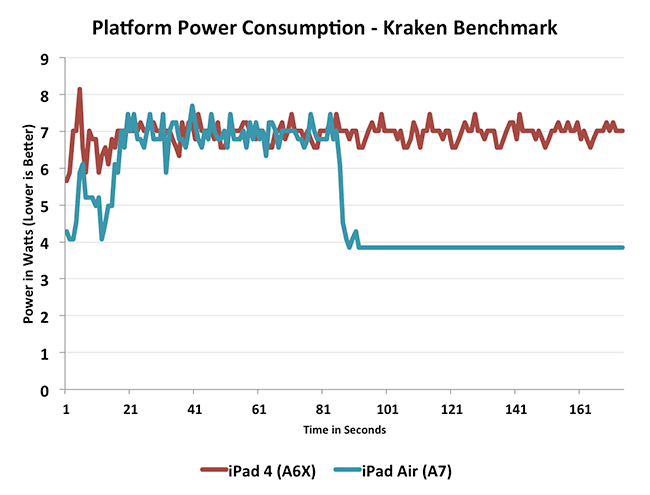
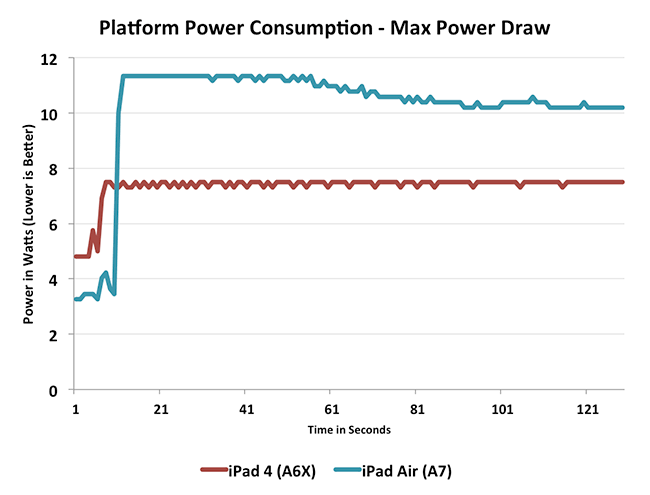








444 Comments
View All Comments
tetsuk - Friday, November 15, 2013 - link
The Macbook Air is great. However, as you mentioned, iWork is not comparable to Office. Since bootcamp works really well, it could still be an option.syedjalalt - Tuesday, November 5, 2013 - link
AnandTech reviews are so unbiased and true unlike The Verge(iSheeps). They go as much deeper as possible to get the best out of their reviews and articles. This is real journalism. Hats off.johned - Tuesday, November 5, 2013 - link
I have a Nexus 4 (soon to be 5) a Nexus 7 first gen and an iPad 2 (soon to be Air). Sometimes I find all the partisan bickering about this stuff hilarious. I like a good row as much as the next guy but I'm a geek. I just love to play with the stuff. I prefer Android to iOS for my daily driver phone, but come on. Anand seems like he's just like me. He loves the tech, all of it, and if had could articulate the way he does, I probably would've started a website like this myself.I will say this, I really don't understand why people think NFC is dead. I use it at least once a day with Google Wallet on my phone. Both major grocery store chains in my area take it. McDonald's takes it. Now, the carrier based service is tanking because they were greedy and botched it. Google wallet I find very useful, though.
Also, I've never had problems transferring files with it. My brother-in-law has a VZW Droid M and I have Nexus devices and I've sent him files from both my tablet and my phone. The most useful thing about it compared to Apple's Air Drop service is that I can do this without needing a wifi connection.
I can honestly say, that the one thing keeping me from an iPhone right now is NFC because I use it so much. If the 5s had included it, I would be sporting one right now. Google Wallet is already available for iOS.
I keep seeing somebody in here sounding like the Apple App Store marketing manager spewing the tired old line about 400blah blah thousand "iPad optimized" apps. This is nice that they are doing that but I observe two things.
1) Google is trying to standardize apps so that 1 app needs to be made for all devices. Since all current Nexus devices have either a 720p or 1080p display, this is easy. This is simply a different approach than Apple is taking.
2)This means that I only need to buy every app 1 time instead of buying it once for my phone and again (usually for a higher price) on my tablet. Apple could mitigate this buy shipping a standard hi-def resolution on the iPhone which they seem reluctant to do.
Back to the original point. We are all geeks here. I appreciate technology. I have opinions about what I like and don't like, but I come to Anandtech because I like to stay current on everything going on. This site also stays largely unpolitical and sticks to the tech, which is why I don't read Ars as much anymore.
JTravers - Wednesday, November 6, 2013 - link
Not sure what you mean about needing a wifi connection for AirDrop. Is having your wifi turned on an issue? AirDrop uses wifi direct, so although you do need to have your wifi turned on you don't need to be connected to a wifi hotspot.nedjinski - Tuesday, November 5, 2013 - link
but wait - there's more -http://www.displaymate.com/Tablet_ShootOut_3.htm
Mayuyu - Wednesday, November 6, 2013 - link
IGZO display instead of IPS. The chart here is wrong.cheshirster - Wednesday, November 6, 2013 - link
Windows tablets are going to suppress ipads sales in coming months.Still no mention in conclusion. That's hilarious, at some point.
AngryCorgi - Thursday, November 14, 2013 - link
Again, you are listing the #s for GFLOPS/core, not the total GPU GFLOPS on the Rogue chips. You need to clarify that. And the older 554MP4 was 21.6 GFLOPS @ 300MHz (14.4 GFLOPS @ 200MHz, as ID'd by Imagination Tech).Atlink - Saturday, November 30, 2013 - link
I'm truly not trying to stir the pot at all, but I am curious about NFC. I understand what it is, and its possible application, however, I'm not seeing anyone really clamor for it. This whole NFC deal seems like the HD-DVD/Blu-Ray war all over again. Neither side really had a lead until Sony began to tip the scales in their favor due to the PS3's exclusive use of Blu-Ray discs for games.I understand that NFC can be used to do some neat things: pay for food, verify a subway ticket, check into a hotel, etc. The problem that I'm seeing is one that anyone without a NFC phone can see: the lack of NFC-enabled terminals. I would say that Apple is dropping the ball something fierce if there were NFC terminals to scan this and that almost everywhere, but like QR codes, they seem almost like a novelty. I *could* scan that code with my phone by either downloading an application that can do it, and then hoping that the code can be read by the program, and hoping that the URL is worth looking at... or I could just type in the URL right below it (yes, I know not everything has a short URL below it). I *could* use NFC by sitting down with my credit cards in advance, creating an account, punching in the numbers, verifying data, opening the app when needed, sorting through the cards I plan to use, selecting the correct one, ensuring the transaction was accepted by the POS... or I could just use my debit card like I have been doing for years now, swipe once, punch in my PIN, and be done with it.
Like I said, I do think that NFC is a really neat idea, and I would love the saturation to become more prevalent in the US, but as of now, it's kind of a neat idea with no real, practical application. I guess the problem I'm having is trying to understand the importance of having it NOW. Some people use NFC as a selling point, and that just seems odd.
I think that when NFC catches on, and you begin seeing it almost everywhere, then we'll start seeing it in Apple products. No point in putting something in if you aren't going to be able to use it, right?
divps - Saturday, November 30, 2013 - link
I have a Nexus 7 and use an iPhone 5. We also have the iPads, a Nexus 4, a Nexus 5 and a Galaxy Nexus phones in the household. I use the Nexus 7 as my tablet for the things that it is strong at and use the nice iOS ecosystem for Apps that I need and that's generally good enough for me. I like the idea of wireless charging and I'm going to get a wireless charger for the Nexus 4 and Nexus 5. The Micro-USB connector isn't the easiest thing to connect without a little effort and the connector can get fatigued over time. It's also nice if you can just come home and put the phone on the platform and pick it up when you need it. The Apple connector is a lot easier for me to put in but wireless charging would mean that I wouldn't need as many lightning cables at home.The Apple ecosystem is generally smoother and nicer. I recently upgraded my Nexus 7 to KitKat and it ran like a dog and I tried a bunch of things and eventually had to do a factory reset which means that I lost a bunch of things and had to re-add them. There are several threads on this on the Phandroid Nexus 7 forums. The iOS 7 upgrade was a piece of cake compared to the KitKat upgrade. I also found UI differences for some simple things between the Nexus 5 and Nexus 7 on KitKat. On the Nexus 7, you do left and right pulldown for notifications and settings. On the Nexus 7, you do one-finger and two-finger pulldowns for notifications and settings. I had thought that the UIs would be the same but I guess not.
I'm extremely impressed with the Nexus 5 hardware - it's very, very fast, great screen, very thin, good feel in hand. I don't like the layout of the volume control and it has known problems with shutter lag and audio output (which I hope will be fixed with software). It's an incredible value for the money.
The thing that I like about Android is the ease of copying content over to them. You just plug them into a PC and drag and drop your files and the Apps will find them on the device. With iOS, I have to convert videos to MP4, or documents to an iBooks compatible format.
I think that the music player and email apps on iOS are far better than the OS provided ones on Android. Google should have done a better job copying iOS Apps there.